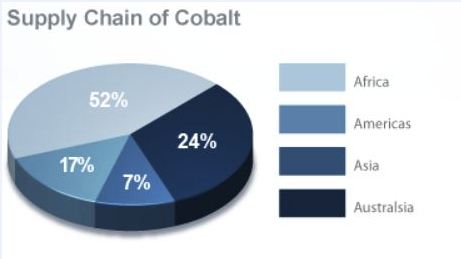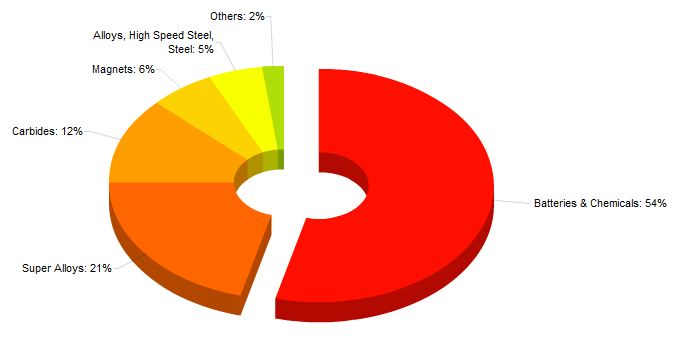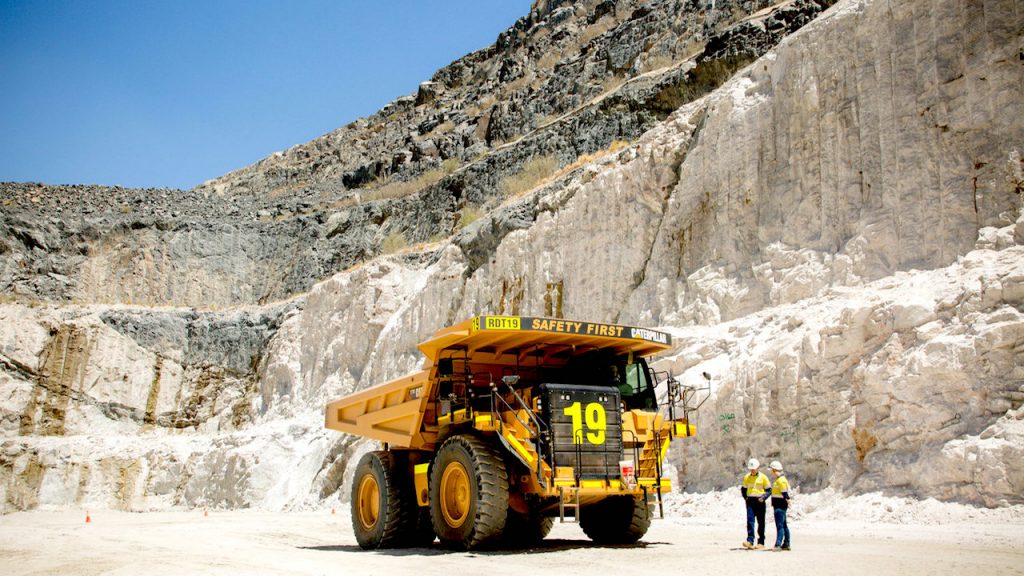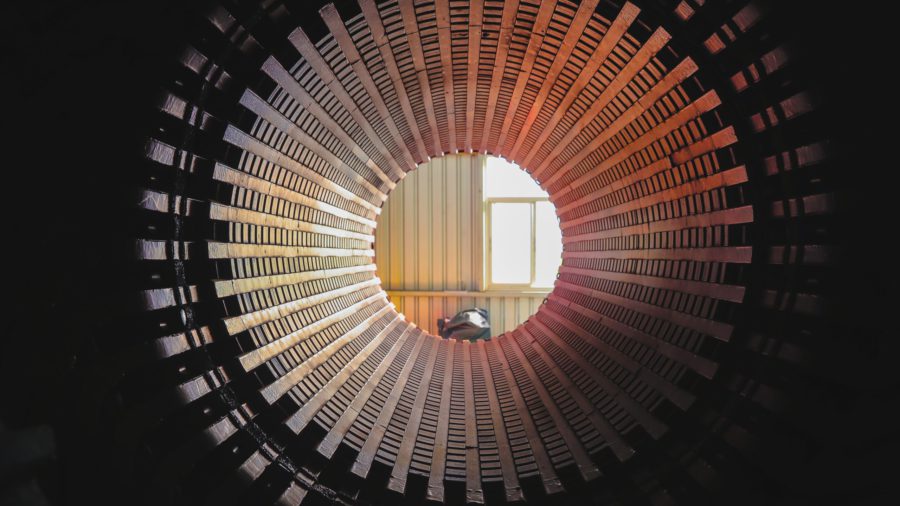Global cobalt
Most of the world’s cobalt is mined in Africa and the majority of Africa’s cobalt comes from the Democratic Republic of Congo.
The DRC represented about 55 percent of global mine supply in 2012 and the country contains almost 50 percent of known worldwide cobalt reserves.
The DRC wants miners to process all their mined ore in the country to encourage more value-added production. On April 5th 2013, the government gave companies 90 days to clear stocks and halt exports of unrefined copper and cobalt – export streams are to be switched from ores and concentrates to refined products.
“It (the export ban – editor) will be fully enforced by July or August in order to allow mining operators to re-adjust themselves. The government is fully aware that mining operators have electricity problems.” DRC Mines Minister Martin Kabwelulu speaking to Reuters
The DRC has tried to impose such an export ban twice (in 2007 and again in 2010), imposition failed on both counts because of a lack of power in the country – the DRC suffers from acute electricity shortages despite a vast network of rivers.
Existing hydro plants, Inga I and Inga II, only produce about a quarter of their joint capacity of 1,700 MW because of low Congo River water levels and poor maintenance. Inga 3 wasn’t built because of concerns over the business climate in Congo. If the first phase, called Inga 3 Low Head does get built, South Africa will receive just over 50 percent of planned power output. The government actually expects power shortages to worsen in the coming years and that by 2020/21 there will be a power shortage of some 5,000 MW.
The country’s frequent brownouts and blackouts, and an expected increase in electricity shortages, do not bode well for an increase in refining capacity. Already less than 10 per cent of the DRC’s 70 million people have access to power, and mining companies are scaling back production and expansion plans because of power shortages.
The news of the DRC’s impending export ban comes as the country is reviewing its mining code – the government is going to overhaul mining laws with an eye to boosting state revenues by increasing tax rates and raising the government’s minimum automatic stake in mining projects, proposals include:
- Enlarge governments stake from five percent to 35 percent in projects, the 35 percent would be “free and non dilutable”
- Increase royalties to gain greater state revenues from the sector
- Introduce a 50 percent levy, a windfall-profit tax, on miners’ “super profits” – when a commodity’s price rises over 25 percent compared with its level at the time of the project’s feasibility study
- Scale back the length of exploration permits to three years, from the four and five year permits available under the current code
- Exploitation phase of mining licenses to be reduced to 25 years from 30 years
- Companies be required to sign written commitments to protect the environment and help local communities
- Pay a capital-gains tax in the event of a takeover
- Projects, after production start, may no longer benefit from preferential customs rates on imports destined for use in mining
According to an Internal Displacement Monitoring Centre (IDMC) report from May 2013. “There were more highly violent conflicts in Africa in 2012 than at any time since 1945.”
The Democratic Republic of the Congo (DRC) – previously known as Zaire – is no exception to the violence flaring in many parts of Africa.
According to IDMC’s report, armed conflict in the eastern part of the Congo intensified “dramatically” during 2012. The increase in fighting drove up the number of displaced people to record levels – there are more than 2.6 million internally displaced people (IDPs) in the country.
Traditionally the DRC’s North and South Kivu regions have been the main areas of extreme turbulence over the past decades. The mineral resources contained in these provinces have provided a steady source of wealth/funding for the various factions claiming its mines.
The hugely mineral rich copper belt region of the DRC, the Congo’s Katanga Province, has also been producing industrial metals such as copper and cobalt for decades, historically the region has been very quiet and not been caught up in the vicious conflicts in Congo’s North and South Kivu.
Unfortunately conditions have deteriorated sharply in the eastern provinces, including Katanga. Very recently, hundreds of insurgents belonging to the Mai Mai Kata Katanga (“cut out Katanga” in Swahili) militia – one of several local militias operating in the province – clashed with security forces in the streets of Katanga’s capital city Lubumbashi. According to the United Nations at least 35 people were killed. The attack was the largest in the province of Katanga in more than a decade. The transport of minerals was interrupted and authorities imposed a nighttime curfew in Lubumbashi.
The DRC holds two major distinctions:
- It is the richest country in the world in terms of mineral wealth, at an estimated $24 trillion.
- It is the country in which the highest number of people – estimates go as high as ten million – have died due to war since World War II.
Cobalt is a strategic and critical metal used in many diverse industrial and military applications.
The growing political risk and socio-economic dissension within the DRC are creating mounting concern for the security of cobalt’s global supply chain.
“The Democratic Republic of Congo faces what is probably the most daunting infrastructure challenge on the African continent”. World Bank report on DRC Infrastructure
Jim Rogers is well known as ‘The Commodities King’, he co-founded the legendary Quantum Fund with George Soros and authored two highly respected investing books – Investment Biker & Adventure Capitalist. Mr. Rogers is very bullish on investing in Russia having been quoted in numerous publications as saying Russia’s leader, president Vladimir Putin, wants to shake his thug KGB image and Russia stacks up as a good contrarian play.
Well I’m not in the habit of investing on anybody’s say so. I do my own due diligence, make my own decisions and take full responsibility for being right AND wrong.
BUT
I have to agree with Mr. Rogers in that I believe Russia has at least one good investment, one for strategic and critical metals (including cobalt) hungry resource junior investors.
The company’s name is Global Cobalt Corp. TSX.V: GCO and it has recently started trading after a considerable halt, amazing project acquisitions, and a name change from Puget Ventures.
Global Cobalt is going to fast-track development of its world-class Karakul Cobalt Project in the Altai Republic of Russia’s southern Siberia. Having historic Soviet C1+C2 resources estimated at 14.98 million tonnes of 0.28% cobalt equivalent Co eq. (0.21% cobalt Co; 0.09% bismuth Bi, 0.44% copper Cu and 0.11% tungsten WO2) with additional P1 resources of 46 million tonnes containing 82,800 tonnes of cobalt – all non NI 43-101 compliant – the Karakul Project has the potential of being the largest known primary cobalt asset outside of Africa.
Global Cobalt also plans to bring on stream a solid pipeline of other strategic and critical metal projects creating a mining district with enormous potential.
Four additional assets, collectively known as the Altai Sister Properties (cobalt-tungsten), have been optioned for acquisition by Global Cobalt. The proximity of the Sister properties to the Karakul Cobalt Deposit adds the possibility of an extension to the main ore bodies providing significant upside to the creation of a new mining jurisdiction in Altai.
Conclusion
Global Cobalt Corp., with its highly qualified management team has the exploration, development and production expertise to enable timely, skilled development of their impressive asset portfolio.
Global Cobalt is the first mover into a new mining region, the mineral rich, pro-mining Altai Republic of Russia’s southern Siberia. GCO is the pioneer, the first foreign, investable, publicly traded mining company to advance the mineral resources in the entire region.
And that’s the investment opportunity, investors get to position themselves at the forefront of a move into an immense, resource rich untapped region, much like what happened with early movers into Mongolia and Kazakhstan.
Global Cobalt Corp. TSX.V: GCO should be on all our radar screens. It’s definitely on mine, is it on yours?
If not, it should be.
***
Contact Richard (Rick) Mills via rick@aheadoftheherd.com
Richard is the owner of Aheadoftheherd.com and invests in the junior resource/bio-tech sectors. Get in touch with him if you’re interested in learning more about the junior resource and bio-med sectors, and quality individual company’s within these sectors.
His articles have been published on more than 400 websites, like the Wall Street Journal, Market Oracle, USA Today, National Post, Montreal Gazette, Vancouver Sun, CBS news, Calgary Herald, Resource Investor, Forbes and Financial Sense.
For Richard Mills’ legal notice/disclaimer, see Aheadoftheherd.com
More News
Tianqi Lithium returns to loss on prolonged battery metal rout
The Chinese lithium giant posted a net loss of 7.9 billion yuan ($1.1 billion) in 2024 citing weaker prices.
March 26, 2025 | 11:46 am
Copper price touches new high as traders predict $12,000
The most-traded contract on the COMEX rallied to a new high of $5.3740 per lb, or about $11,840 per tonne.
March 26, 2025 | 10:49 am
{{ commodity.name }}
{{ post.title }}
{{ post.excerpt }}
{{ post.date }}






Comments